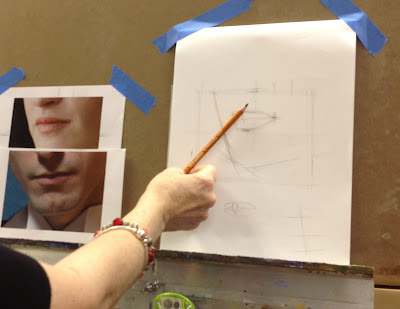Art Lesson Du Jour
Spend Less Time on the Ropes to Make Better Work
(dedicated to my champion students)
(dedicated to my champion students)
Fact: It's a simple truth that every painting and drawing are a series of corrections.
When taking a jab at art, each mark is our best guess in relationship to the other marks we've made. It's the best mark we can make right then, at that moment in time. We make it knowing full well that it is likely to change, and that's ok. Later in the process we will know better.
Problem: Panic, strong emotions, and harsh self-criticism will defeat the creative process.
When taking a jab at art, each mark is our best guess in relationship to the other marks we've made. It's the best mark we can make right then, at that moment in time. We make it knowing full well that it is likely to change, and that's ok. Later in the process we will know better.
Problem: Panic, strong emotions, and harsh self-criticism will defeat the creative process.

I often see students in a knock-down, drag-out with themselves when things aren't going well in a drawing or painting. Their critique of the work becomes a criticism of self. It's easy to allow the critical voices of one's insecurities or the nasty voices of others into your head. I've been there and done that as well. Trust me, when you let those guys talk, no constructive critique is going on!
When I see my students hitting below the belt I say, "Hey, don't talk to my student that way," "Would I say that to you?" or "Would you say that to anyone else in your life?" Of course the answer is always "No!"
Panic too can creep in during frustrating moments. We live a fast paced life with instant gratification and the sheer time required to look and see properly can make an artist feel panic. The brain is constantly yelling, "This is taking too long." We feel certain that everyone else is figuring this stuff out with more agility and speed than we are.
All this self-doubt and emotional thinking clog up the creative process, so that's why it's important to have a strategy in place.
When I see my students hitting below the belt I say, "Hey, don't talk to my student that way," "Would I say that to you?" or "Would you say that to anyone else in your life?" Of course the answer is always "No!"
Panic too can creep in during frustrating moments. We live a fast paced life with instant gratification and the sheer time required to look and see properly can make an artist feel panic. The brain is constantly yelling, "This is taking too long." We feel certain that everyone else is figuring this stuff out with more agility and speed than we are.
All this self-doubt and emotional thinking clog up the creative process, so that's why it's important to have a strategy in place.

Your brain without a plan.
Solutions: Click READ MORE below for answers.






















VBlog.jpg)


























